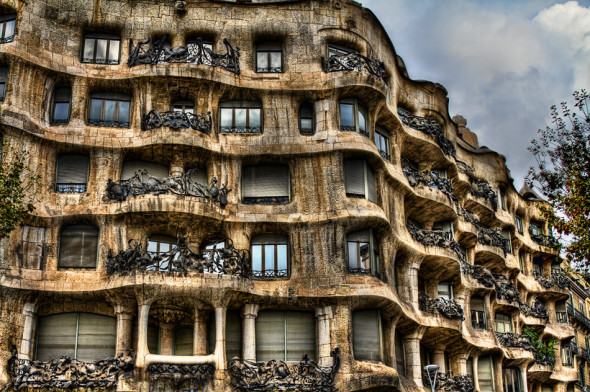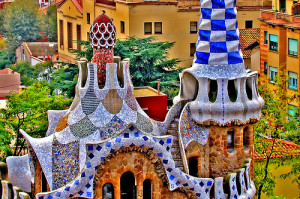Throughout the course of history; against every regime of conventionalism rebels have emerged, canvassing their opinions through art, literature, philosophy, poetry, theatre, education or by whatever means possible, and one such solider of the Modernism movement was Antonio Gaudi, celebrated architect of Barcelona. Like many other pioneers of truly brilliant ideas and much celebrated work, Gaudi was highly criticized for his unconventional ideas and dynamic architectural techniques during his lifetime, however, his work is now widely celebrated and studied; and his masterpiece the Sagrada Família, which remains incomplete to this day due to his death, is the most visited architectural monument in all of Catalonia. Several of his other magnificent works are now considered World Heritage Sites by UNESCO who highly credit Gaudi’s work and declare that ‘these monuments represent an eclectic, as well as a very personal, style which was given free rein in the design of gardens, sculpture and all decorative arts, as well as architecture’. The seven most prominent works of Gaudi are considered to be: Parque Güell; Palacio Güell; Casa Mila; Casa Vicens; Gaudi’s work on the Nativity façade and Crypt of La Sagrada Familia; Casa Batlló; Crypt in Colonia Güell.
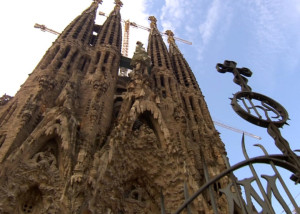
Front of the Sagrada Familia
Gaudi’s work from the late 18th Century, especially during the days of his further education, was influenced by the neo-gothic art and an oriental modus operandi, such as working with spires, pointed arches and columns, however, Gaudi believed that the Gothic style was still imperfect, half finished, like a broken body that is supported by crutches, though it was still reflected in most of his early work. The work of the famous nineteenth century French architect Eugène Viollet-le-duc was of an inspirational interest to Gaudi. The French architect mainly focused on the refurbishment of old cathedrals and castles, with a devoted focus on the formation of the building and a strong gothic style. Gaudi’s earlier work included designing lampposts for the Palace Reial in Barcelona, and he started working on the infamous Sagrada Família in 1884. His bold work and daring techniques caused him grave criticism from the crowds, however, he had numerous wealthy admirers who supported and commissioned his body of work. 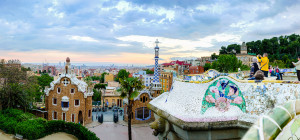
Parque Guell in Barcelona
As Gaudi continued to work on piece after piece, his uncanny ability to create beautiful, unique buildings was displayed for all to see. Gaudi’s architectural approach tended to begin with natural, biomorphic forms which then spiraled out into an almost artistic collage of thoughts, feelings and dispositions. As his vision progressed through his work, at the beginning of the twentieth century, many of Gaudi’s works represent both a transition from the preceding application of the Gothic style and a step frontward on the way to an exuberant expressivity as reflected in his designs of the Crypt of the church at the Colònia Güell and the Calvet House. Much of his work uses whimsical, pliable and fluid formations rather than harsh, solid lines that reflect the poetic inner complexities of the human mind and soul so magnificently in his work. An example of this style of work is the Casa Milá (La Pedrera), whose exterior mirrors the flowing waves of the sea. The terraced roof of the edifice offers a truly characteristic panorama into the ‘Gaudiesque’ style with its asymmetrical chimneys standing tall like soldiers, covered with multicoloured broken tiles. The multicoloured tiles are another signature trait of Gaudi’s fashion, most visible in his work in Park Güell.
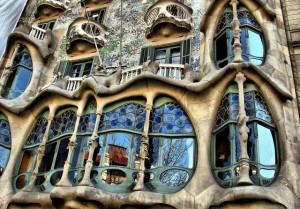 Casa Batllo
Casa Batllo
Gaudi believed in the organic synthesis that the manifestation in his work flowed through nature and the expression of his own beliefs and like in nature itself, the function created the form. His work esthetic portrayed that architecture absolutes the beauty of nature by accomplishing unbreakable balance. Formation and function bond in the expressive mold, and incarnate into the meaning of the work. The true representation of this climax has to be the temple of Sagrada Família which communicates an imagery of profound religiosity and also resonates with the Catholic liturgy in a manner totally coherent with Gaudi’s philosophical religious ideals.
Aside from the array of sentiment that seemingly follows from Gaudi’s work, his work also infuses, through its melting waves and lopsided spirals, a sense of playfulness and exudes a fairytale like imagery for the onlooker. His work stimulates thought, and provokes the imagination of anyone who sets eyes on it. Another example of Gaudi’s iconic design and his unique imagery is the Casa Batlló. Faced with the assignment of simply reinstating the exterior of this old house, Gaudi incorporated his creative flamboyance and artistic panache into the project and produced a fantastical building as a result. This building is a true representation of Gaudi’s signature style as he was widely known to always push the boundaries of what was conventionally possible and created buildings that were exclusive and exceptional in their era. The restoration of the glorious multicoloured façade of Casa Batlló, with shining chunks of glass decorating its walls and its scaled roof that resembles a colossal spine of a dragon, nothing has even come close to encapsulating this level of fantasy within a functional building. Mesmerizing the streets of Barcelona, the inspiring structure feels more like an image out of Disneyland, a bit of entertaining amusement amidst the miasma of a metropolitan capital.



